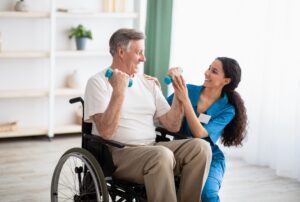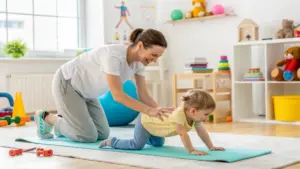
When families and individuals are looking for the best way to support health, recovery, and development, one question often comes up: Is in-home therapy effective? The short answer is yes—for many children and adults, in-home therapy can be just as effective, and sometimes even more beneficial, than traditional clinic-based care. Here’s why:
1. Comfort of a Familiar Environment
Being in a safe, familiar environment can reduce stress and make it easier to engage in therapy activities. Children often feel more relaxed at home than in a clinic, and adults recovering from stroke, Parkinson’s, or musculoskeletal injuries may feel more comfortable practicing exercises in their own space. This comfort allows therapists to observe natural movement patterns, assess postural alignment, and design interventions tailored to each individual’s daily routines.
2. Family and Caregiver Involvement
In-home therapy makes it easier for family members or caregivers to be directly involved. Parents can participate in pediatric sessions, while spouses or adult children can learn techniques to support neuroplasticity, functional mobility, and activities of daily living (ADL) recovery for adults. This collaboration ensures that therapeutic exercises, manual therapy techniques, and home exercise programs are consistently reinforced, improving long-term outcomes.
3. Personalized to Daily Life
Therapists can integrate clinical approaches such as constraint-induced movement therapy (CIMT) for children with hemiplegia or balance and gait training for adults recovering from stroke or orthopedic surgery. Examples include:
- A child practicing articulation exercises using toys and household objects
- An adult performing functional strength exercises on stairs or with adaptive equipment
- Building fine motor skills during mealtime, dressing, or play activities
This clinical customization enhances carryover and relevance to everyday tasks.
4. Convenience for Busy Families and Adults
In-home therapy eliminates commuting and waiting times, allowing more frequent and consistent sessions. Adults undergoing neurorehabilitation or post-surgical therapy benefit from increased adherence to structured protocols and neuromuscular re-education, which can accelerate recovery timelines.
5. Effective Outcomes
Research shows that when caregivers are actively engaged and therapy strategies are practiced at home, outcomes improve. In-home therapy supports motor learning principles, neuroplasticity, and skill generalization, strengthening both pediatric developmental gains and adult functional recovery.
6. Flexibility With Virtual Options
Teletherapy provides guided exercise programs, real-time monitoring, and caregiver coaching using video consultations. This approach supports therapeutic continuity, remote assessments, and adjustments to interventions like task-specific training or sensory integration activities.
The Bottom Line
In-home therapy is clinically effective for children and adults, leveraging evidence-based interventions in a familiar environment. Whether it’s pediatric developmental support, post-stroke neurorehabilitation, or functional mobility improvement, therapy at home allows licensed therapists to provide targeted, evidence-driven care.
If you’re considering therapy, Welldom Therapy offers both in-home and virtual options for children and adults. Our licensed therapists provide personalized, evidence-based care designed to help each individual thrive in the comfort of home. Contact Welldom Therapy today to schedule a consultation and start your journey toward progress and independence.



